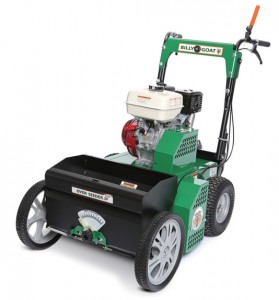 Can Billy Goat overseeders improve your lawn?
Can Billy Goat overseeders improve your lawn?
Yes!
How? The answer to that is a little more complicated: there are several benefits to overseeding, but getting the most out of this process requires the right timing and preparation.
What is Overseeding?
When you think of seeding, you probably think of getting grass to grow over bare patches of turf to create a uniform lawn. However, if that’s all the seeding you do, your lawn will thin out as the grass matures and more successful plants take over more space.
Overseeding is the process of seeding turf that already has grass growing on it. By introducing this new growth, the lawn stays thick with young grass without having to be completely reworked.
Why Should I Overseed?
Overseeding isn’t just useful for thinning lawns, it can help your lawn from thinning in the first place by maintaining new grass growth. It can also be used as a strategy for keeping your lawn green longer by mixing together warm weather and cold weather grasses so at least part of the lawn is active throughout the entire growing season. This doesn’t just improve the look of your landscaping: adding cold weather grasses together with fertilizer and mulch give warm grasses protection through the fall and winter.
When Should I Overseed?
If you live in the northern part of the U.S, there are two peak times for adding cold winter grasses to your lawn: during spring and between late summer and early fall. Ideally, the grass should be seeded at least 45 days before the first frost.
Live in the southern parts of America where freezing is less of an issue? Aim for late spring for optimum coverage, or fall to keep your lawn green for a longer period.
How Do I Prepare my Lawn for Overseeding?
The seeds need to make contact with the ground to take root. Mow the grass to a height of two inches or less; if you’re overseeding in the south, go as low as you can and scalp the grass. Clippings should be bagged so they don’t block the soil. Using a dethatcher or rake to remove any thatch that could act as a barrier between the seeds and the soil.
If your lawn has any soil or bald spot issues, they need to be resolved before seeding.
How Do I Use My Billy Goat Overseeder?
Once you’ve selected the right grass for your conditions and climate, it’s just a matter of setting up your overseeder and moving it across the lawn. The rate you need to deposit the seed will be marked on the seed packaging. Full instructions on setting the seed rate for the OS 500 series can be found under the lid of the seed hopper. If you have an OS901, the seed rate can be set using the lever at the front of the hopper.
Don’t be surprised if you use a little less seed than recommended by the grower: both overseeders use Billy Goat’s Auto Drop system which disperses the seeds evenly without pushing them too close together, so they use the seed more efficiently to get the coverage you need. Both models also have a blade that helps the seeds penetrate into the soil, so even if you didn’t perfectly cut and dethatch the lawn, there’s still a good chance they’ll be worked into the soil and sprout.
After the Seeding
Keeping the soil moist is critical for the first four days after planting. Water the turf lightly twice a day during this period, then switch to heavier waterings every other day for the next 5 days. At this point, you should be able to switch back to your normal lawn care routine.
Maintaining Your Billy Goat Overseeder
When you need parts for your Billy Goat equipment, go to www.billygoatparts.com. We carry everything you need for your overseeder from replacement blades to engine parts so you can keep your lawn looking lush, and we can ship your order to any address in the U.S. and Canada.
